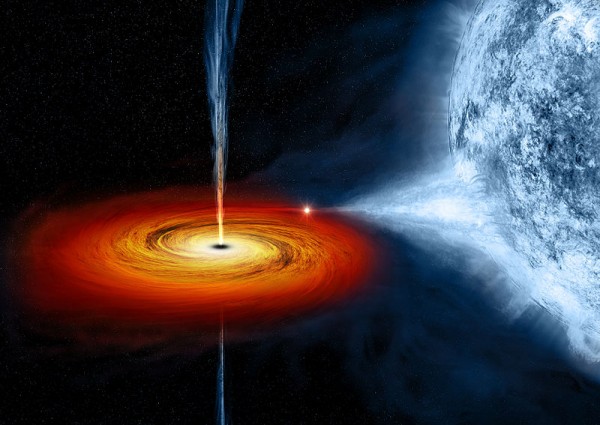Sleeping Black Hole Finally Wakes Up
| KJ Belonio | | Jul 03, 2015 10:37 AM EDT |
(Photo : Wikimedia Commons/NASA) Astronomers recently discovered a sleeping black hole that has finally awakened after its 26-year nap.
Outer space is indeed a vast scientific wonderland! And just recently, astronomers discovered a sleeping black hole that has finally awakened after its 26-year nap.
On June 15, an active black hole released a burst of X-rays that lit up astronomical observatories. According to Space.com, the now-active black hole was identified as an "X-ray nova," has projected a sudden increase in star luminosity that came from a binary system in the Cygnus constellation.
Like Us on Facebook
So, what are black holes? Black holes are very dense, massive celestial objects that have an immensely powerful gravitational field that traps anything and everything that comes too close, including light. And occasionally, they spit out and suck in materials.
For the first time in 26 years, astronomers got ecstatic after a nearby black hole erupted. The outburst from the two-body system called V404 Cygni, which is made up of a star slightly smaller than the sun that orbits a black hole 10 times its mass, was first captured by NASA's Swift satellite. And then by a Japanese experiment on the International Space Station called Monitor of All-sky X-ray Image (MAXI).
"Relative to the lifetime of space observatories, these black hole eruptions are quite rare," Swift's principal investigator at NASA's Goddard Space Flight Center, Neil Gehrels said in a statement. "So, when we see one of them flare up, we try to throw everything we have at it, monitoring across the spectrum, from radio waves to gamma-rays."
Since the star orbits so closely to the black hole, the massive body attracts a stream of gas away from the star. Over time, the gas forms a circle around the black hole. But when the gas is cooler, it's able to resist the black hole's pull, NBC News has learned.
Moreover, as more gas accumulates and reaches temperatures of more than 1.7 million degrees Fahrenheit, a jet of high-energy particles are emitted. These bursts are what the satellites like NASA's Swift instrument detected - albeit 80 centuries later because of the time it takes light to travel from the V404 Cygni to Earth.
Meanwhile, this stellar duo has been active before, but only at irregular intervals. In 1938 and 1956, the system was caught fluctuating in visible light. However, astronomers didn't have half of the instruments that are around today, Business Insider reported.
In 1989, another outburst was documented and was observed by instruments aboard Russia's Mir space station and a Japanese X-ray satellite called Ginga.
Outbursts like this typically only last for a few weeks to months. So in order to study the black hole in all wavelengths ranging from very low energy like radio waves to the most energetic like gamma rays, astronomers have culminated a total of nine instruments in space and on the ground before time runs out.
TagsEarth, outer space, Science
©2015 Chinatopix All rights reserved. Do not reproduce without permission
EDITOR'S PICKS
-

Did the Trump administration just announce plans for a trade war with ‘hostile’ China and Russia?
-

US Senate passes Taiwan travel bill slammed by China
-

As Yan Sihong’s family grieves, here are other Chinese students who went missing abroad. Some have never been found
-

Beijing blasts Western critics who ‘smear China’ with the term sharp power
-

China Envoy Seeks to Defuse Tensions With U.S. as a Trade War Brews
-

Singapore's Deputy PM Provides Bitcoin Vote of Confidence Amid China's Blanket Bans
-

China warns investors over risks in overseas virtual currency trading
-

Chinese government most trustworthy: survey
-

Kashima Antlers On Course For Back-To-Back Titles
MOST POPULAR
LATEST NEWS
Zhou Yongkang: China's Former Security Chief Sentenced to Life in Prison

China's former Chief of the Ministry of Public Security, Zhou Yongkang, has been given a life sentence after he was found guilty of abusing his office, bribery and deliberately ... Full Article
TRENDING STORY

China Pork Prices Expected to Stabilize As The Supplies Recover

Elephone P9000 Smartphone is now on Sale on Amazon India

There's a Big Chance Cliffhangers Won't Still Be Resolved When Grey's Anatomy Season 13 Returns

Supreme Court Ruled on Samsung vs Apple Dispute for Patent Infringement

Microsoft Surface Pro 5 Rumors and Release Date: What is the Latest?










